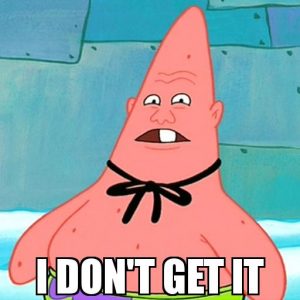
…actually, I do get it; I was just being facetious.
To explain: I obviously follow the research evidence and how that informs clinical practice and clinical decision making very carefully. If that research stacks up to scrutiny, then it has to inform clinical practice and be factored into the models that underpin clinical practice. What we do and understand must change with the new evidence. That is how knowledge, science and clinical practice progresses.
Good science, good theory and good clinical practice takes into account all evidence, wherever it goes and takes into account all arguments and all research, and most importantly: changes when new evidence suggest that it should.
Bad science, bad theory and bad clinical practice will often start with a conclusion and then searches out only the evidence that supports that (ie cherry picking, confirmation bias) and either ignores or is hostile towards research that does not confirm those preconceived biases.
In that context, I always find it intriguing when tracking what and how new research is shared and linked on social media. It typically follows that good/bad science pattern. I usually just do the roll eyes and shake the head as you see the cherry picking and confirmation biases play out. I sometimes comment or troll them and sometimes get blocked for my comment (that is another sign of bad science and bad theory in that they are hostile to criticism, are dogmatic and don’t engage).
I like to think I have a clear conscious on this. I think if you check my social media accounts, I frequently post links to content that may be seen as contradictory to what people unrealistically claim as my preconceived biases. I also obviously post links that support my alleged preconceived views. What I do try and be careful at doing is evolving my ideas, views and models as that evidence accumulates. Those that have heard any of my lectures over a longer period of time know how they change with the evidence and not just the cherry-picked evidence (and also a somewhat sense of embarrassment over what I might I believed/said many years ago).
What motivated me today to get back to writing on this blog post was something that has played out in the last week or so in social media concerning several studies that were just published. Personally, I shared ALL of them on social media and not just the one(s) I like. That was not done by others who like to only share cherry-picked content that supports their preconceived biases.
The first study that was widely shared and liked and positively commented on by those with one particular agenda was this study by Kulmala et al that reported that:
We found that highly cushioned maximalist shoes alter spring-like running mechanics and amplify rather than attenuate impact loading.
That conclusion got quite a mileage in social media and looking at the posting history of those who shared it, it is probably not a surprise (I won’t get into methods issues in the study (they are fine) or make too many comments on the spin they put in the results (which is bad), but maybe another time).
The purpose of this blog post and what I wanted to point out is that to ask why those who shared that, did also not share this study by Meardon et al
These results suggest that increasing shoe cushioning properties ∼10–20% may benefit individuals susceptible to high loads at the ankle, and to a lesser extent knee and hip, during running
Could it be because it did not support their agendas?
or this study by Sinclair:
Peak Achilles tendon force was significantly larger (P = 0.039) when running barefoot (6.85 BW) compared to shod (6.07 BW). In addition, both medial (P = 0.013) and lateral (P = 0.007) tibiofemoral instantaneous load rates were significantly larger in the barefoot (medial 289.17 BW/s and lateral 179.59 BW/s) in relation to the shod (medial 167.57 BW/s and lateral 116.40 BW/s) condition. Finally, the barefoot condition (9.70 BW) was associated with a significantly larger (P = 0.037) peak hip force compared to running shod (8.51 BW).
Could it be because it did not support their agendas?
All three studies were published pretty much in the same week. I shared all three in my social media accounts. However, tracking how they were or were not shared in social media by others was a text book lesson in cherry-picking and confirmation bias.
I could ask why they do that? and say, I just don’t get it. I do know why they do it and I do get why they do it. They shouldn’t do it.
I did respond with comments to ask why they posted one and not the other or both, only to get a couple of blocks or comments deleted or ignored or if I got a response, it was clear that they just did not get it.
If we want our understanding of science, knowledge and clinical practice to progress we have to do better than just support what confirms our preconceived biases.
As always, I go where the evidence takes me until convinced otherwise …. critical thinking skills please

Looking forward to hearing the snake oil responses to this. Glad somebody is posting things with no agenda on this topic. Thanks for what you do.
Wouldn’t one expect to find higher load rates when running barefoot vs. unshod since there isn’t cushioning and arch support to disperse the load bearing? As I understand it, the idea with barefoot running is that you are making the body do the work that supportive shoes assist in. Not sure why this would be a surprise to anyone…
Maybe I’m missing the point here though, please let me know